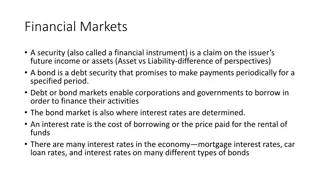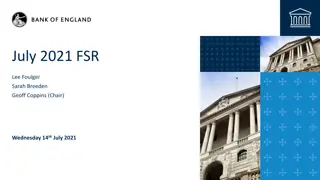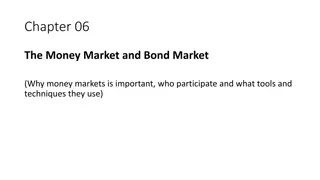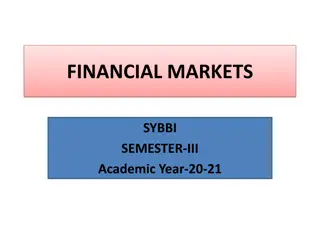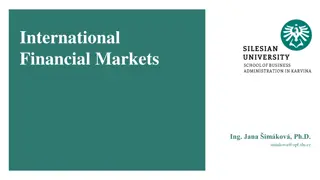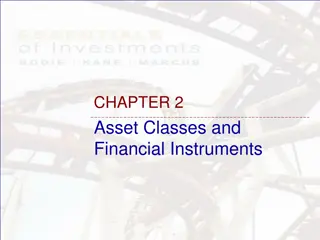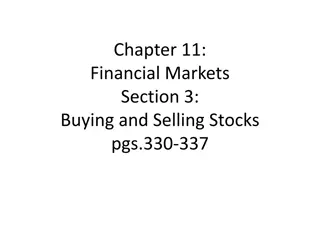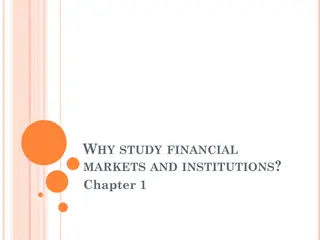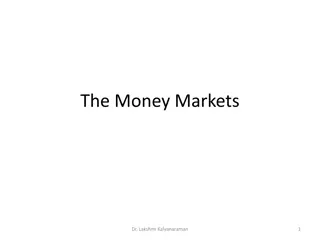Understanding Financial Markets in India
Financial markets play a crucial role in connecting lenders and borrowers, providing avenues for investment and capital generation. In India, the financial system includes money markets and capital markets, offering diverse financial products and opportunities for investors. Money markets deal with short-term debt instruments, while capital markets focus on long-term investments. These markets enhance liquidity, allow risk diversification, and contribute to economic growth by efficiently channeling capital.
Download Presentation

Please find below an Image/Link to download the presentation.
The content on the website is provided AS IS for your information and personal use only. It may not be sold, licensed, or shared on other websites without obtaining consent from the author. Download presentation by click this link. If you encounter any issues during the download, it is possible that the publisher has removed the file from their server.
E N D
Presentation Transcript
Financial Markets MSMSR/BBA/605 (F) DSE Dr. Akshita Sharma Asst. Prof. (MSMSR) MATS University, Pandri, Raipur (C.G.) MSMSR/BBA/605 (F) DSE Financial Markets 1
Text Books 1. Financial institutions and Markets : L.M.Bhole 2. Indian Securities market: Hooda.R.P 3. Monetary Economics: Suraj Gupta MSMSR/BBA/605 (F) DSE Financial Markets 2
MODULE I An overview of financial markets in India; Money markets: Indian money markets structure and compositions: Acceptance houses, Discount house, and call money market, recent trends in Indian money market. MSMSR/BBA/605 (F) DSE Financial Markets 3
An overview of financial markets in India Financial Markets are an important component of a country s financial system. It is the infrastructure that connects lender and borrowers. In simple terms, individuals who have surplus money invest in securities and entities which requires capital issues securities. The investors earn a return on the security while the entity gets capital for growing or expanding its business. Let us understand this with the help of an example. Person A has excess amount and wants to invest it. He can deposit the amount in bank and earn a fixed interest. However, if he invests in stocks, he can earn higher returns. The financial market creates an alternative for the individual who has a higher risk appetite and wants to earn higher returns. Banks also use the money we deposit for giving loan to companies MSMSR/BBA/605 (F) DSE Financial Markets 4
An overview of financial markets in India . In Financial Market, we directly lend money to companies and get interest or returns. Financial markets are a mechanism for the exchange trading of financial products within a policy framework. They are characterized by a large volume of transactions and the speed with which financial resources move from one owner to the other. They perform the important functions of an efficient payment mechanism, providing information about companies, enhancing liquidity of financial claims, transmutation of financial claims to suit the preferences of both savers and borrowers, diversification and reduction of risk, and an efficient source for capital generation and investment. Financial Markets consist of two distinct types of markets Money Market and Capital Market. MSMSR/BBA/605 (F) DSE Financial Markets 5
Money Market The money market is a market for short-term debt instruments with maturity below one year. It is a highly liquid market where securities are bought and sold in large quantities to reduce transaction cost. Such securities are often risk free. Call money market, certificates of deposits, commercial paper, repo and treasury bills are the major instruments of the money market. Money market constitutes a very important segment of the financial system as it facilitates the conduct of monetary policy. The main investors in money market are financially strong entities such as banks and mutual funds. Participation of retail investors is less due to low returns in comparison to other markets. The money market is regulated by the Reserve Bank of India. MSMSR/BBA/605 (F) DSE Financial Markets 6
Capital Market Capital market is an institutional arrangement for the trading of medium and long-term securities or equity and debt. The major purpose of capital markets is to mobilize long-term savings and finance long-term investments. It also provides liquidity with a mechanism enabling the investor to sell financial assets, encourages broader ownership of productive assets, lowers the cost of transactions and information and improves the effectiveness of capital allocation by way of a competitive pricing mechanism. So, it comprises of all long- term borrowings from banks as well as financial institutions, borrowings from foreign markets and raising of capital by issuing several securities such as shares, debentures, bonds, etc. MSMSR/BBA/605 (F) DSE Financial Markets 7
Capital Market The market participants in capital markets is widespread and includes everyone from Retail Investors to Strong Financial Entities such as Banks and Mutual Funds. SEBI is the main regulator when it comes to capital market. Capital markets can be further classified into primary and secondary markets. Primary Markets The primary market is also known as the new issue market. It consists of mechanisms for procurement of long-term funds by fresh issues of shares and debentures. Secondary Market The secondary market is also called the stock market. It provides a ready market for long term securities. The secondary market has two components: over- the-counter (OTC) market and the exchange traded market. MSMSR/BBA/605 (F) DSE Financial Markets 8
Types of Capital Markets Debt Market- Debt market is the financial market where investors buy and sell debt securities, typically in the form of bonds. These markets are vital sources of funds, particularly in a developing economy like India. A fairly well-segmented debt market has emerged in India comprising the following: Private corporate debt market Public sector undertaking bond market Government securities market The government securities market accounts for nearly 90 per cent of the business in the debt market. It constitutes the major segment of the debt market. MSMSR/BBA/605 (F) DSE Financial Markets 9
Types of Capital Markets Equity Market- Equity market, often known as the stock market or share market, is a place where shares of companies or entities are traded. The market enables sellers and buyers to deal in equity or shares in the same platform. Equities are mostly traded on the stock exchanges in India. In the Indian stock market, equities are available for trading at the National Stock Exchange (NSE) , the Bombay Stock Exchange (BSE) and the latest entrant, Metropolitan Stock Exchange of India (MSE). MSMSR/BBA/605 (F) DSE Financial Markets 10
Types of Capital Markets Forex Market- The Foreign Exchange Market, also known as the Forex Market, is a market where people can trade in currencies. It is one of the most liquid markets. Indian law allows forex trading only in currency derivatives. RBI and SEBI strictly regulates trading in foreign currencies in India. Hence, Forex Trading in India is not as prevalent as the stock market or money market. Derivatives Market- A derivative instrument is a contract whose value is derived from the value of another asset, known as the underlying, which could be a share, a stock market index, an interest rate, a commodity, or a currency. The derivative market in India was introduced in the year 2000. Derivatives market can be classified into forwards, futures, options and swaps. MSMSR/BBA/605 (F) DSE Financial Markets 11
Indian money markets structure and compositions The Indian monetary market has two broad categories the organized sector and the unorganized sector. Organized Sector: This sector comprises of the governments, the RBI, the other commercial banks, rural banks, and even foreign banks. The RBI organizes and controls this sector. Other corporations like the LIC, UTI, etc also participate in this sector but not directly. Other large companies and corporates also participate in this sector through banks. Unorganized Sector: These are the indigenous banks and the local money lenders and hundis etc. Their activities are not controlled by the RBI or any other body, so they are the unorganized sector. MSMSR/BBA/605 (F) DSE Financial Markets 12
Acceptance Houses A financial institution that guarantees a bill of exchange, as a result of which it can be discounted on more favorable terms. An acceptance market is a contractual agreement involving the use of short-term credit as payment in international trade. It is commonly used between exporters and importers, allowing the seller to get paid faster. An importer signs and sends a bill back to the exporter, indicating they are willing to pay for goods by a certain date. The exporter can sell the bill for a discount. MSMSR/BBA/605 (F) DSE Financial Markets 13
Discount House Discount houses are financial institutions that act as money lenders, or serve as intermediaries between commerical lenders and borrowers, trading in various short-term securities and instruments. Mainly located in the U.K., discount houses once provided a ready secondary market, thus ensuring liquidity in the British monetary system. The Bank of England often operated through discount houses to help regulate the money supply, set interest rates, and extend credit to commercial banks. By 2000, British discount houses largely ceased to exist as separate financial institutions. MSMSR/BBA/605 (F) DSE Financial Markets 14
Call Money Market Call money and call money markets, in general, are characterized by very short term loans. Call money loans typically range from one to 14 days. They can include institutional participants such as in the interbank call money market. Other types of call money markets also exist. Brokerages may use call money markets to cover margin accounts. Call money rates are usually influential in the margin borrowing rates of brokerage accounts since call money serves as a source of funds to cover margin lending. Call money loans typically do not have set repayment schedules since they are so very short term coming to maturity within two weeks. Thus, call money is used for very short term needs and is repaid quickly. MSMSR/BBA/605 (F) DSE Financial Markets 15
Recent trends in Indian money market The money market involves the purchase and sale of large volumes of very short-term debt products, such as overnight reserves or commercial paper. An individual may invest in the money market by purchasing a money market mutual fund, buying a Treasury bill, or opening a money market account at a bank. Money market investments are characterized by safety and liquidity, with money market fund shares targeted at $1. MSMSR/BBA/605 (F) DSE Financial Markets 16
Assignment Q.1. What is Financial Markets? Q.2. What are types of Financial Markets? Q.3. Write Short on:- a. Acceptance house b. Discount house. MSMSR/BBA/605 (F) DSE Financial Markets 17
MODULE II Capital market: Security market (a) New issue market (b) Secondary market; functions and role of stock exchange, Listing, Pricing of public issue, Stock exchanges and over the counter exchanges. MSMSR/BBA/605 (F) DSE Financial Markets 18
Capital market Capital markets refer to the venues where funds are exchanged between suppliers and those who seek capital for their own use. Suppliers in capital markets are typically banks and investors while those who seek capital are businesses, governments, and individuals. Capital markets are used to sell different financial instruments, including equities and debt securities. These markets are divided into two categories: primary and secondary markets. The best-known capital markets include the stock market and the bond markets. MSMSR/BBA/605 (F) DSE Financial Markets 19
Security market (a) New issue market The primary market is where securities are created. It's in this market that firms sell (float) new stocks and bonds to the public for the first time.An initial public offering, or IPO, is an example of a primary market. These trades provide an opportunity for investors to buy securities from the bank that did the initial underwriting for a particular stock.An IPO occurs when a private company issues stock to the public for the first time. For example, company ABCWXYZ Inc. hires five underwriting firms to determine the financial details of its IPO. The underwriters detail that the issue price of the stock will be $15. Investors can then buy the IPO at this price directly from the issuing company. MSMSR/BBA/605 (F) DSE Financial Markets 20
Security market (a) New issue market This is the first opportunity that investors have to contribute capital to a company through the purchase of its stock. A company's equity capital is comprised of the funds generated by the sale of stock on the primary market. Types of Primary Offering Arights offering (issue) permits companies to raise additional equity through the primary market after already having securities enter the secondary market. Current investors are offered prorated rights based on the shares they currently own, and others can invest anew in newly minted shares. Other types of primary market offerings for stocks include private placement and preferential allotment. MSMSR/BBA/605 (F) DSE Financial Markets 21
Security market (a) New issue market Private placement allows companies to sell directly to more significant investors such as hedge funds and banks without making shares publicly available. While preferential allotment offers shares to select investors (usually hedge funds, banks, and mutual funds) at a special price not available to the general public. Similarly, businesses and governments that want to generate debt capital can choose to issue new short- and long-term bonds on the primary market. New bonds are issued with coupon rates that correspond to the current interest rates at the time of issuance, which may be higher or lower than pre-existing bonds. The important thing to understand about the primary market is that securities are purchased directly from an issuer. 22 MSMSR/BBA/605 (F) DSE Financial Markets
The Secondary Market For buying equities, the secondary market is commonly referred to as the "stock market." This includes the New York Stock Exchange (NYSE), Nasdaq, and all major exchanges around the world. The defining characteristic of the secondary market is that investors trade among themselves. That is, in the secondary market, investors trade previously issued securities without the issuing companies' involvement. For example, if you go to buy Amazon (AMZN) stock, you are dealing only with another investor who owns shares in Amazon. Amazon is not directly involved with the transaction. In the debt markets, while a bond is guaranteed to pay its owner the full par value at maturity, this date is often many years down the road. MSMSR/BBA/605 (F) DSE Financial Markets 23
The Secondary Market Instead, bondholders can sell bonds on the secondary market for a tidy profit if interest rates have decreased since the issuance of their bond, making it more valuable to other investors due to its relatively higher coupon rate. The secondary market can be further broken down into two specialized categories: Auction Markets- In the auction market, all individuals and institutions that want to trade securities congregate in one area and announce the prices at which they are willing to buy and sell. These are referred to as bid and ask prices. The idea is that an efficient market should prevail by bringing together all parties and having them publicly declare their prices. MSMSR/BBA/605 (F) DSE Financial Markets 24
The Secondary Market Thus, theoretically, the best price of a good need not be sought out because the convergence of buyers and sellers will cause mutually agreeable prices to emerge. The best example of an auction market is the New York Stock Exchange (NYSE).1 Dealer Markets- In contrast, a dealer market does not require parties to converge in a central location. Rather, participants in the market are joined through electronic networks. The dealers hold an inventory of security, then stand ready to buy or sell with market participants. These dealers earn profits through the spread between the prices at which they buy and sell securities. An example of a dealer market is the Nasdaq, in which the dealers, who are known as market makers, provide firm bid and ask prices at which they are willing to buy and sell a security.2 The theory is that competition between dealers will provide the best possible price for investors. MSMSR/BBA/605 (F) DSE Financial Markets 25
The Secondary Market The OTC Market- Sometimes you'll hear a dealer market referred to as an over-the-counter (OTC) market. The term originally meant a relatively unorganized system where trading did not occur at a physical place, as we described above, but rather through dealer networks. The term was most likely derived from the off-Wall Street trading that boomed during the great bull market of the 1920s, in which shares were sold "over-the-counter" in stock shops. In other words, the stocks were not listed on a stock exchange, they were "unlisted." Over time, however, the meaning of OTC began to change. The Nasdaq was created in 1971 by the National Association of Securities Dealers (NASD) to bring liquidity to the companies that were trading through dealer networks.3 At the time, few regulations were placed on shares trading over-the-counter, something the NASD sought to improve. As the Nasdaq has evolved over time to become a major exchange, the meaning of over-the-counter has become fuzzier. Nowadays, the term "over-the-counter" generally refers to stocks that are not trading on a stock exchange such as the Nasdaq, NYSE, or American Stock Exchange (AMEX). This means that the stock trades either on the over-the-counter bulletin board (OTCBB) or the pink sheets. Neither of these networks is an exchange; in fact, they describe themselves as providers of pricing information for securities. OTCBB and pink sheet companies have far fewer regulations to comply with than those that trade shares on a stock exchange. Most securities that trade this way are penny stocks or are from very small companies. For these reasons, while the Nasdaq is still considered a dealer market and, technically, an OTC, today's Nasdaq is also a stock exchange and, therefore, it is inaccurate to say that it trades in unlisted securities. MSMSR/BBA/605 (F) DSE Financial Markets 26
Functions of stock exchange Role of an Economic Barometer: Stock exchange serves as an economic barometer that is indicative of the state of the economy. It records all the major and minor changes in the share prices. It is rightly said to be the pulse of the economy, which reflects the state of the economy. Valuation of Securities: Stock market helps in the valuation of securities based on the factors of supply and demand. The securities offered by companies that are profitable and growth-oriented tend to be valued higher. Valuation of securities helps creditors, investors and government in performing their respective functions. Transactional Safety: Transactional safety is ensured as the securities that are traded in the stock exchange are listed, and the listing of securities is done after verifying the company s position. All companies listed have to adhere to the rules and regulations as laid out by the governing body. Contributor to Economic Growth: Stock exchange offers a platform for trading of securities of the various companies. MSMSR/BBA/605 (F) DSE Financial Markets 27
Functions of stock exchange This process of trading involves continuous disinvestment and reinvestment, which offers opportunities for capital formation and subsequently, growth of the economy. Making the public aware of equity investment: Stock exchange helps in providing information about investing in equity markets and by rolling out new issues to encourage people to invest in securities. Offers scope for speculation: By permitting healthy speculation of the traded securities, the stock exchange ensures demand and supply of securities and liquidity. Facilitates liquidity: The most important role of the stock exchange is in ensuring a ready platform for the sale and purchase of securities. This gives investors the confidence that the existing investments can be converted into cash, or in other words, stock exchange offers liquidity in terms of investment. Better Capital Allocation: Profit-making companies will have their shares traded actively, and so such companies are able to raise fresh capital from the equity market. Stock market helps in better allocation of capital for the investors so that maximum profit can be earned. Encourages investment and savings: Stock market serves as an important source of investment in various securities which offer greater returns. Investing in the stock market makes for a better investment option than gold and silver. MSMSR/BBA/605 (F) DSE Financial Markets 28
Role of stock exchange 1. Mobilization of Savings? Capital Markets are one of the most sought-after platforms for institutional investors as well as individuals. To ensure investor s protection, all the trading transactions in the capital markets are regulated with proper regulations and rules. This also helps in consolidating the confidence of small savers and individual investors. In this way, stock exchanges help in attracting savings from large number of investors in the capital markets. 2. Promoting Capital Formation - The mobilization of funds from the savers by the capital markets is channelized to various industries which are involved in production and manufacturing of various goods and services which is beneficial for the economy. This enhances the capital formation and development of the national assets. This channelization of savings into appropriate avenues of investment is one of the primary roles of the stock exchanges. MSMSR/BBA/605 (F) DSE Financial Markets 29
Role of stock exchange 3. Liquidity of Investment- As an investor, it is very important to consider the liquidity of your investment. This liquidity is provided by the stock exchanges. Investors can liquidate their securities and other capital market assets anytime during the trade hours and days. Therefore, stock exchanges help in ensuring liquidity of investment. The online trading carried out on the stock exchanges after dematerialization of securities has transformed the trading experience. It helps investors in buying, selling and transferring their investment seamlessly. 4. Investment Safety- One of the most important role of stock exchange in ensuring investment safety to the investors. After the dematerialization act, trading on stock exchanges has been completely online. The Securities and Exchange Board of India (SEBI) keeps an eye on the functioning of exchanges and keeps on identifying new loopholes in the system. Several measures are enforced at times to overcome the same and ensure investment safety. The authorities at exchanges try their best to curb speculative practices and minimize the risk for investors to safeguard their confidence. MSMSR/BBA/605 (F) DSE Financial Markets 30
Role of stock exchange 5. Wide Marketability to Securities- In the earlier days, trading on stock exchanges was done using physical security certificates. The trading was limited to the office of the stock exchange and all dealings were carried out over there only. Investors from distant parts of the country remain in the dark about the price movements on exchanges. After the establishment of online trading system, investors can keep an eye on the price movements and make the most out of all the price movements in the capital markets. The modern stock exchanges backed by information technology have provided wide marketability to the securities. 6. Funds for Development Purpose- As we have already discussed, stock exchanges help in mobilization and channelizing of funds from savers to various industries. Many times, these industries are the one which are involved in government development projects including infra companies, railways, telecommunications etc. Stock exchanges help in constant evaluation of government securities. 7. Barometer of National Economy- The stock exchanges are considered to be the barometer of a nation s economy. The economy of a country is economically symbolized by the most significant stock exchange of that particular country. These stock exchanges help in representing the progress and situation of a nation s economy at national and international levels. For instance, Bombay Stock Exchange or BSE is often considered by overseas investors to have an idea about the economic condition of our country. MSMSR/BBA/605 (F) DSE Financial Markets 31
Listing In corporate finance, a listing refers to the company's shares being on the list (or board) of stock that are officially traded on a stock exchange. Some stock exchanges allow shares of a foreign company to be listed and may allow dual listing, subject to conditions. Normally the issuing company is the one that applies for a listing but in some countries an exchange can list a company, for instance because its stock is already being traded via informal channels. Stocks whose market value and/or turnover fall below critical levels may be delisted by the exchange. Delisting often arises from a merger or takeover, or the company going private. MSMSR/BBA/605 (F) DSE Financial Markets 32
Pricing of public issue The public offering price (POP) is the price an underwriter sets for new issues of stock sold to the public during an initial public offering (IPO). Underwriters look at a variety of factors when setting the public offering price, such as the profitability of the company, the strength of its financial statements, growth trends, and investor confidence. Underwriters need to set a POP that is low enough to attract the attention of investors, yet high enough to ensure the company raises a satisfactory amount of money through the new stock issue. Some qualitative factors such as the public's perception of a company or the desire to invest in the next hot tech company can sometimes push the share price beyond the public offering price, particularly during the early days of an IPO. MSMSR/BBA/605 (F) DSE Financial Markets 33
Pricing of public issue Understanding a Public Offering Price (POP) Investors and analysts sometimes use the POP price as a benchmark against which a stock's current price can be compared. If a company's share price rises significantly above its initial public offering price, the company is considered to be performing well. However, if the share price later dips below its initial public offering price, this is considered a sign that investors have lost confidence in the company's ability to create value. A public offering price does not necessarily reflect what the shares are worth. Investors can get overly excited about a hot new company and push prices higher than the stock should be. By using the balance sheet information contained in the prospectus, prospective investors can calculate an accurate share value to help determine whether the market has correctly priced an IPO. MSMSR/BBA/605 (F) DSE Financial Markets 34
Pricing of public issue The Underwriting Process It's the underwriting company's job to evaluate the company interested in an IPO to determine an optimal public offering price. The underwriter must take many variables into consideration during this process. First, the public offering price must accurately reflect the current and potential near-term worth of the underlying company. The underwriter will need to undertake a thorough review of the company's financial statements, which includes the balance sheet, income statement, and cash flow statement. Additionally, the underwriter will need to set a POP that is high enough to ensure the company raises a satisfactory amount of money through the equity issue. Lastly, the POP must be low enough to attract the attention of investors and motivate them to buy shares of the new offering. MSMSR/BBA/605 (F) DSE Financial Markets 35
Pricing of public issue How to Research Public Offering Prices The main way to research an IPO price is to contact the underwriting bank for the offering and get a copy of the prospectus. Find the financial data contained in the prospectus. Locate the balance sheet and find the stockholder s equity section. Look for the amount under the paid-in capital heading, which is the money the company has received from the sale of IPO stock. As an example, let s say the balance sheet reports $500,000 as the amount of paid-in capital. Locate the number of shares the company has sold in the stockholders' equity section. Divide the paid-in capital by the number of shares sold to get the value of one share of stock. For example, if the company has sold 25,000 IPO stock shares for $500,000, you would divide the $500,000 paid-in capital amount by the 25,000 shares to arrive at a $20-per-share book value. MSMSR/BBA/605 (F) DSE Financial Markets 36
Stock exchanges and over the counter exchanges BASIS FOR COMPARISON OTC (OVER THE COUNTER) EXCHANGE Meaning Over the Counter or OTC is a decentralized dealer market wherein brokers and dealers transact directly via computer networks and phone. Exchange is an organized and regulated market, wherein trading of stocks takes place between buyers and sellers in a safe, transparent and systematic manner. Market maker Dealer Exchange itself Used by Small companies Well established companies Physical Location No Yes Trading hours 24 7 Exchange hours Stocks Unlisted Stocks Listed Stocks Transparency Low Comparatively high Contracts Customized Standardized 37 MSMSR/BBA/605 (F) DSE Financial Markets
Assignment Q.1. Write a comparison between money and capital market? Q.2. Differentiate between Primary & secondary Market. Q.3. Differentiate between OTC & stock exchange. 38
MODULE III Securities contract and regulation act: Main provisions; Investor s protection: Grievances handling and their removal. 39 MSMSR/BBA/605 (F) DSE Financial Markets
Securities contracts (Regulations) Act 1956 Introduction: The Securities Contracts (Regulation) Act, 1956 Act was enacted in order to prevent undesirable transactions in securities and to regulate the working of stock exchanges in the country. The provision of the Act came into force with effect from 20th February, 1957 vide Notification No. SRO 528 dated 16th February, 1957. Definitions: Stock exchange [Section 2(j)] any body of individuals, whether incorporated or not, constituted before corporatization and demutualization under sections 4A and 4B, or a body corporate incorporated under the Companies Act, 1956 whether under a scheme of corporatization and demutualization or otherwise, for the purpose of assisting, regulating or controlling the business of buying, selling or dealing in securities MSMSR/BBA/605 (F) DSE Financial Markets 40
Securities contracts (Regulations) Act 1956 Recognized Stock Exchange [Section 2(f)] means a stock exchange which is for the time being recognized by the Central Government under Section 4 of the Act. Corporatization [Section 2(aa)] means the succession of a recognized stock exchange, being a body of individuals or a society registered under the Societies Registration Act, 1860 (21 of 1860), by another stock exchange, being a company incorporated for the purpose of assisting, regulating or controlling the business of buying, selling or dealing in securities carried on by such individuals or society. Demutualization [Section 2(ab)] means the segregation of ownership and management from the trading rights of the members of a recognized stock exchange in accordance with a scheme approved by the Securities and Exchange Board of India (SEBI). The main parts of the Act are as follows and the powers of Central Government with regard to this Act are exercisable by SEBI: (A) Recognized Stock Exchanges (B) Penalties MSMSR/BBA/605 (F) DSE Financial Markets 41
Securities contracts (Regulations) Act 1956 Corporatization and demutualization of stock exchanges (Section 4A) On and from the appointed date, all recognized stock exchanges (if not corporatized and demutualised before the appointed date) shall be corporatized and demutualised in accordance with the provisions contained in section 4B. Procedure for corporatization and demutualization (Section 4B) 4B(1): All recognized stock exchanges referred to in section 4A shall, within such time as may be specified by the SEBI, submit a scheme for corporatization and demutualization for its approval 4B(2): On receipt of the scheme, the SEBI after making such enquiry as may be necessary and if it is satisfied that it may approve the scheme with or without modification. Note: appointed date means the date which the SEBI may, by notification in the Official Gazette, appoint and different appointed dates may be appointed for different recognized stock exchanges. MSMSR/BBA/605 (F) DSE Financial Markets 42
Securities contracts (Regulations) Act 1956 Corporatization and demutualization of stock exchanges (Section 4A) On and from the appointed date, all recognized stock exchanges (if not corporatized and demutualised before the appointed date) shall be corporatized and demutualised in accordance with the provisions contained in section 4B. Procedure for corporatization and demutualization (Section 4B) 4B(1): All recognized stock exchanges referred to in section 4A shall, within such time as may be specified by the SEBI, submit a scheme for corporatization and demutualization for its approval 4B(2): On receipt of the scheme, the SEBI after making such enquiry as may be necessary and if it is satisfied that it may approve the scheme with or without modification. Note: appointed date means the date which the SEBI may, by notification in the Official Gazette, appoint and different appointed dates may be appointed for different recognized stock exchanges. MSMSR/BBA/605 (F) DSE Financial Markets 43
Securities contracts (Regulations) Act 1956 Corporatization and demutualization of stock exchanges (Section 4A) On and from the appointed date, all recognized stock exchanges (if not corporatized and demutualised before the appointed date) shall be corporatized and demutualised in accordance with the provisions contained in section 4B. Procedure for corporatization and demutualization (Section 4B) 4B(1): All recognized stock exchanges referred to in section 4A shall, within such time as may be specified by the SEBI, submit a scheme for corporatization and demutualization for its approval 4B(2): On receipt of the scheme, the SEBI after making such enquiry as may be necessary and if it is satisfied that it may approve the scheme with or without modification. Note: appointed date means the date which the SEBI may, by notification in the Official Gazette, appoint and different appointed dates may be appointed for different recognized stock exchanges. MSMSR/BBA/605 (F) DSE Financial Markets 44
Securities contracts (Regulations) Act 1956 Power of Central Government to call for periodical returns or direct inquiries to be made (Section 6) Every recognized stock exchange shall furnish to SEBI periodical returns relating to its affairs as may be prescribed. Every recognized stock exchange and every member thereof shall preserve such books of accounts and other documents for period of not exceeding five years. Annual reports to be furnished to Central Government by stock exchanges (Section7) Every recognized stock exchange shall furnish the Central Government a copy of the annual report. Power of recognized stock exchanges to make bye-laws (Section 9) 9(1) Any recognized stock exchange may, subject to the previous approval of the SEBI, make bye-laws for the regulation and control of contracts. Power of SEBI to make or amend bye-laws of recognized stock exchanges (Section 10) 10(1) The SEBI may either on a request from the governing body of a recognized stock exchange or on its own motion make bye-laws for all or any of the matters specified in section 9 or amend any bye-laws made by such stock exchange under that section. MSMSR/BBA/605 (F) DSE Financial Markets 45
Securities contracts (Regulations) Act 1956 Power to suspend business of recognized stock exchanges (Section 12) The Central Government is empowered to suspend the business of recognized stock exchange on an emergency situation by giving notification in the Official Gazette stating the reasons therein, for a period of not exceeding seven days and subject to such conditions as may be specified in the notification. However, in the interest of the trade or the public the said period can be extended from time to time, provided that no such period of suspension can be extended, unless the governing body of the recognized stock exchange has been given an opportunity of being heard in the matter. Conditions for listing (Section 21) Where securities are listed on the application of any person in any recognized stock exchange, such person shall comply with the conditions of the listing agreement with that stock exchange. MSMSR/BBA/605 (F) DSE Financial Markets 46
Securities contracts (Regulations) Act 1956 Delisting of securities (Section 21A) 21A(1): A recognized stock exchange may delist the securities, after recording the reasons therefore, on any of the ground or grounds as may be prescribed under this Act, provided that the securities of a company shall not be delisted unless the company concerned has been given a reasonable opportunity of being heard. 21A(2): A listed company or an aggrieved investor may file an appeal before the Securities Appellate Tribunal (SAT) against the decision of the recognized stock exchange within fifteen days from the date of the decision of the recognized stock exchange, provided that SAT may, if it is satisfied that the company was prevented by sufficient cause from filing the appeal within the said period, allow it to be filed within a further period not exceeding one month. MSMSR/BBA/605 (F) DSE Financial Markets 47
Securities contracts (Regulations) Act 1956 Section 22 - Right of appeal against refusal of stock exchanges to list securities of public companies Where a recognized stock exchange refuses to list the securities of any public company or collective investment scheme, the company or scheme may appeal to the Central Government against such refusal, omission or failure, as the case may be: within fifteen days from the date on which the reasons for such refusal are furnished to it, or where the stock exchange has omitted or failed to dispose of, within the time specified in sub-section (1) of section 73 of the Companies Act, 1956 (1 of 1956) (hereafter in this section referred to as the specified time ), the application for permission for the shares or debentures to be dealt with on the stock exchange, within fifteen days from the date of expiry of the specified time or within such further period, not exceeding one month, as the Central Government may, on sufficient cause being shown, allow. MSMSR/BBA/605 (F) DSE Financial Markets 48
Securities contracts (Regulations) Act 1956 Section 22A - Right of appeal to Securities Appellate Tribunal against refusal of stock exchange to list securities of public companies Where a recognized stock exchange refuses to list the securities of any public company or collective investment scheme, the company or scheme may appeal to the SAT against such refusal, omission or failure, as the case may be: within fifteen days from the date on which the reasons for such refusal are furnished to it, or where the stock exchange has omitted or failed to dispose of, within the time specified in sub-section (1A) of section 73 of the Companies Act, 1956 (1 of 1956), (hereafter in this section referred to as the specified time ), the application for permission for the shares or debentures to be dealt with on the stock exchange, within fifteen days from the date of expiry of the specified time or within such further period, not exceeding one month, as the Securities Appellate Tribunal may, on sufficient cause being shown, allow. Section 22D Limitation- The provisions of the Limitation Act, 1963 (36 of 1963) shall, as far as may be, apply to an appeal made to a Securities Appellate Tribunal. MSMSR/BBA/605 (F) DSE Financial Markets 49
Investors protection Investors protection is a wide term, it encompasses of all the measures designed to protect investors from malpractices of brokers, companies managers to issue, merchant bankers, registrar to issues etc. The main complaints are against brokers of stock exchanges, against listed companies and mutual funds. Investor protection is one of the crucial elements of a growing securities market. It focuses on making sure that investors are fully informed about their purchases, transactions and the corporate affairs and updates. Various procedures, guidelines, rules and regulation have been issued in the legislations to protect the investor s right and repose their confidence. ROLE OF SEBI IN INVESTOR PROTECTION Investors are the pillar of the financial and securities market. They determine the level of activity in the market. They put the money in funds, stocks, etc. to help grow the market and thus, the economy. 50 MSMSR/BBA/605 (F) DSE Financial Markets




